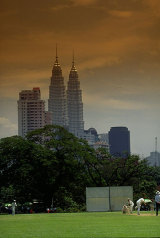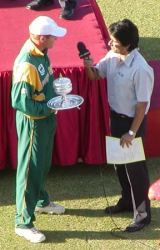Offshore interests
Andrew Miller and Martin Williamson look at some of cricket's offshore venues
|
|

|
Malaysia's burgeoning profile was demonstrated when it was recently awarded the 2008 Under-19 World Cup, and it also features high on the list of places the Indian board has earmarked in its plan for global domination. Kuala Lumpur's only previous major matches took place during the 1998 Commonwealth Games when the catchily-named Perbadanan Kemajuan Negari Selangor ground and the Tenaga National Sports Complex were the main venues. The latter is now the No. 1 centre, but it is still relatively under-developed with marquees and temporary seating very much the order of the day. That is likely to change ahead of 2008.
Hong Kong, as expected of a former British colony, has been home to a thriving cricket community for many years, and the Hong Kong International Sixes in November has become a light-hearted but hard-fought fixture on the international calendar. Given the constant battle for space, it is remarkable that so many grounds survive. The enthusiasm to develop the game in China could well have a knock-on effect, and one of those could be major matches at some of the former colony's wonderful venues. Kowloon Cricket Club, perhaps the most impressive of them all, arguably pips Singapore and Westminster School as being in possession of the most valuable land on which cricket takes place.
Singapore enjoyed a brief spell as cricket's up-and-coming neutral venue in 1999-2000 when it made a thinly-disguised bid to become the "Sharjah of the East". Two successful one-day tournaments were followed by talk of Singapore replacing Toronto on the international merry-go-round. Significant investment meant revamped facilities at one of the most valuable - in terms of real estate - grounds in the world. The situation post match-fixing and 9/11 led to a rethink, but Singapore is well-placed to be one of the centres to benefit from the expansionist approach of the new Indian board.
A US$22 million project funded by the Abu Dhabi government, the Sheikh Zayed Stadium opened in May 2004 as one of the most state-of-the-art stadia in the world, with two large stands at either end and sprawling areas of grass banking for those spectators who like to combine their cricket with sun-worshipping. But, with the rise and rise of the nearby Dubai Sports City, and its brand-new ICC-funded arena, the lifespan of the ground could be brief. To date it has hosted just two underwhelming one-day internationals between India and Pakistan - a pair of dour end-of-season affairs, ostensibly scheduled to raise funds for the Asian Earthquake Appeal. The series was shared one apiece.
|
|

|
In the aftermath of September 11, and with anxieties heightened by the suicide bomb in Karachi that curtailed New Zealand's Test series, Pakistan suddenly found that their opponents were none too keen to contest series in the country. So the players packed their suitcases and set off in search of neutral venues - from Colombo and Sharjah, where they were routed by Australia, to Nairobi and, most improbably of all, Tangier, on the Straits of Gibraltar in Northern Morocco. Though the country had little tradition of cricket, it did have one lowly ground, owned by the Federation Royale Morocaine de Cricket and funded by the Cricketers Benefit Fund Series in Sharjah. Seven matches were played in nine days between Pakistan, South Africa and Sri Lanka in August 2002, with the Sri Lankans walking off with the US$250,000 prize. International cricket has never yet returned.
Amstelveen, on the outskirts of Amsterdam, was inaugurated as an ODI ground when Kenya took on South Africa at the 1999 World Cup, but had to wait another five years before its next international, when India, Pakistan and Australia arrived in August 2004 to contest the Videocon Cup. The tri-series was a warm-up for the Champions Trophy in England later that summer, and in terms of acclimatisation it worked a treat, with every single qualifying match being affected in some way by the weather, including two no-results. More than 10,000 fans turned out to watch the tournament curtain-raiser - between India and Pakistan, naturally - but the audiences dwindled spectacularly thereafter. Even so, the tournament was a qualified success in the eyes of the players themselves. Perhaps speaking on behalf of all the competitors, Inzamam-ul-Haq admitted that he had treated the week away as a holiday.
The hulking frame of Clive Lloyd, huddled beneath a blanket like a geriatric in a bath-chair, is the abiding image of the only full one-day international to have been played at Ireland's home ground in Clontarf, Dublin. Lloyd was manager of the West Indian World Cup squad in 1999, when they overcame Bangladesh in a bitterly cold encounter in May. He had had good reason for a few cold shivers as he crossed the Irish Sea, however. His previous cricket-related visit had come 30 years earlier, when he was part of the 1969 West Indian team that was bowled out by Ireland for 25, in the small town of Sion Mills. That World Cup match won't be Clontarf's only ODI for much longer, however. With the 2007 tournament looming, Ireland have been accorded full ODI status.
|
|

|
The most famous neutral venue, and one which for almost two decades was synonymous with multi-national one-day tournaments until it became tarnished, possibly harshly, with the fall-out from the match-fixing scandals in the late 1990s. The stadium grew from a fairly ramshackle affair in 1981 to a 27,000-seater in the 1990s, usually populated by expat Asians who work in the Emirates in large numbers, but as the international community backed away from matches outside the major countries, fearing that these were more susceptible to the involvement of illegal bookmakers, Sharjah's star waned. In 2001 India banned their side from playing there, and that signalled the beginning of the end. By the time the Indians were ready to again embrace such venues, the multi-million dollar stadium in Abu Dhabi was operational and Dubai City was being built, consigning Sharjah to history.
Central Broward Regional Park was built largely in the hope that it would help the USA's desire to host matches in the 2007 World Cup. That it failed to do so was largely the fault of bitter in-fighting in the USA administration. It cannot be denied, however, that Florida is one of three major centres in the country - Los Angeles and New York are the others - where cricket could be promoted among a large and affluent ex-pat community. The venue - part of a bigger $28 million sporting complex - was designed to have 5000 permanent seats and room for up to 20,000 temporary ones, but the demise of Project USA in 2005 put a serious brake on development. The latest deal between India and West Indies means that Broward is again leading the race to become the USA's first major ODI venue, but local politics continue to be a serious obstacle.
The wonderfully named Toronto Cricket, Skating and Curling Club was the stage for cricket's first attempts at expansion into North America, hosting the Sahara Cup - India v Pakistan - for three years from 1996 and then a tri-series also featuring West Indies in 1999. Temporary stands and gantries converted the ground from a sleepy backwater into an international venue, but there were problems. The first five-match event was marred by bad weather and poor crowds and the second (subtitled the Friendship Cup) is remembered for Inzamam-ul-Haq's remarkable assault on a megaphone-wielding loudmouth in the crowd. The locals objected to such an event being staged - the crowd was almost entirely expats, doing little to support the idea that this would boost the profile of the game in the wider community - and attendances continued to be poor throughout, as did the pitches. Had it not been for a deal binding India and Pakistan to play, the concept would not have limped on for four years. In 1999, 40,570 were in the nearby SkyDome to watch a match between an Asian XI and the Rest of the World, raising hopes that there might be a future for matches in the city.
As Ashes fever took hold last summer, the effects were felt right across the globe - not least in Iraq, where soldiers of the British Light Dragoons and the Australian 2nd Cavalry Regiment contested their own desert version. On a pitch constructed by the Aussie troops, with a matting wicket and boundaries marked by Scimitar tanks and ASLAV armoured vehicles, the troops lined up to watch the action. The British forces wore combats, but the Aussies - one step ahead - had their own replica one-day kit flown in, and duly took the lead in what was to be a five-match series. In 53 degree heat, play had to be suspended when Merlin helicopter caused a sandstorm by landing nearby.